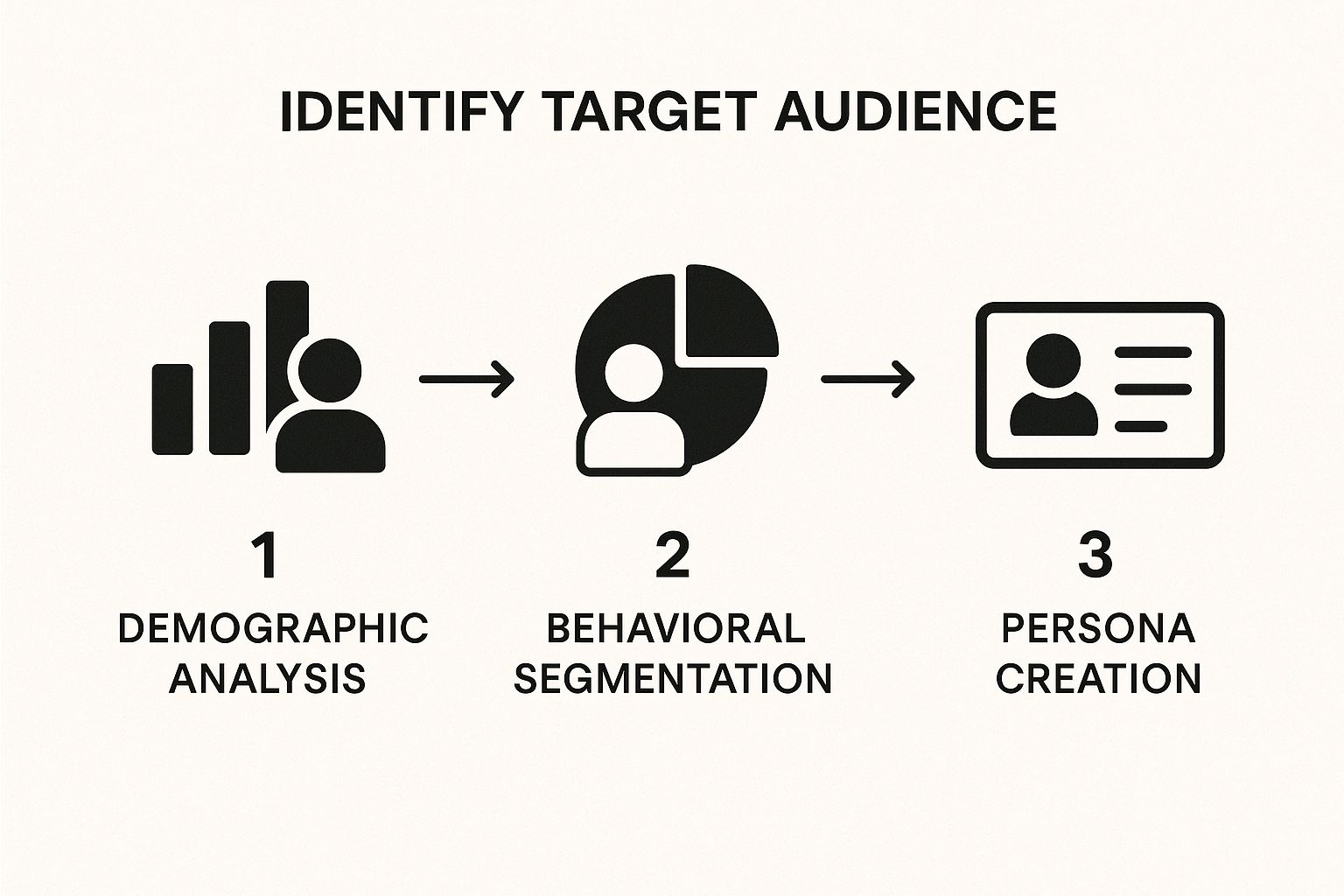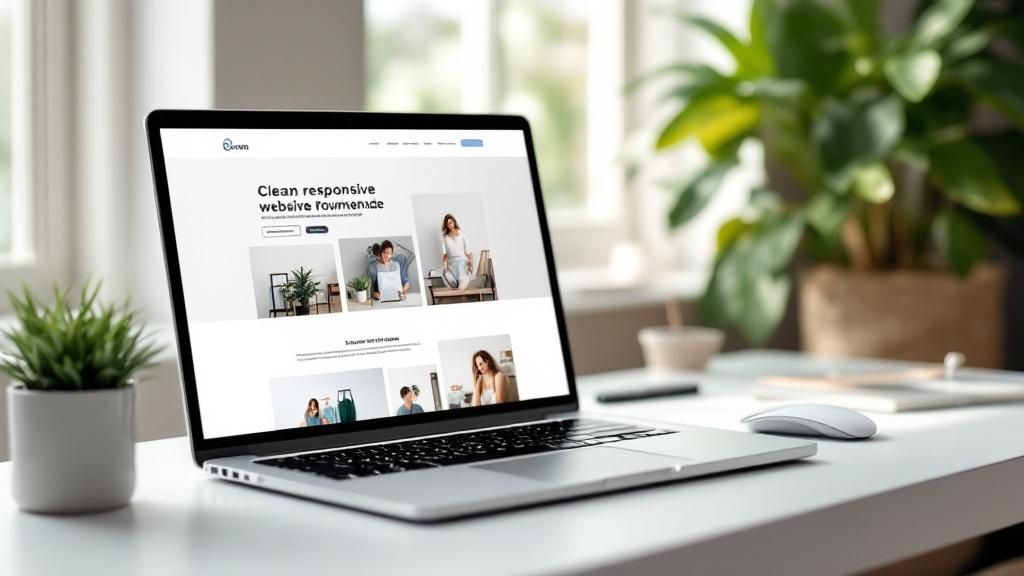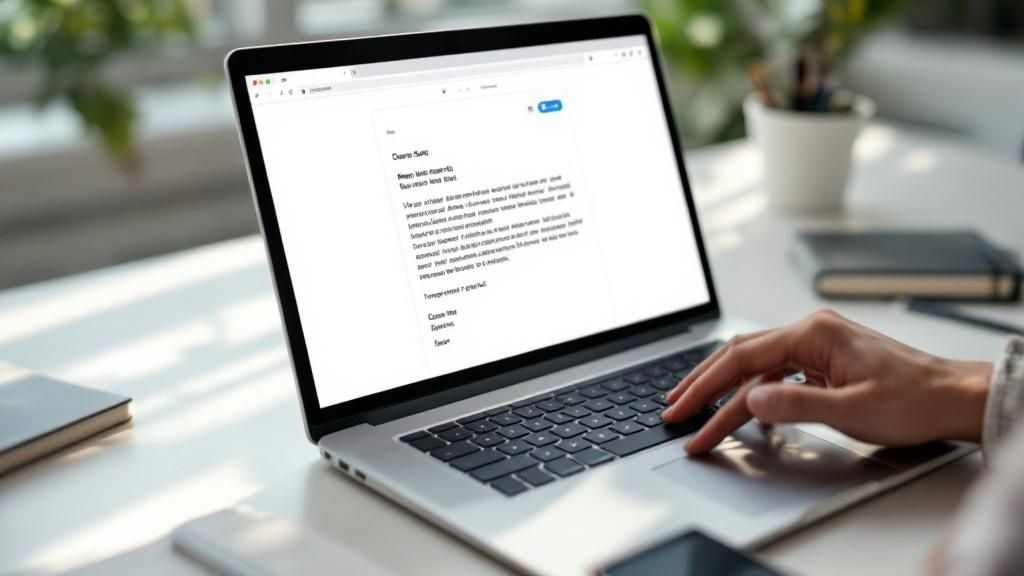You can't fix what you don't measure. It's an old cliché, but it's the absolute truth when it comes to improving your sales conversion rate. The whole game is about moving from guesswork and hunches to a data-driven approach that pinpoints exactly what turns a prospect into a paying customer.
It's a simple formula, really: understand where you are now, fix the obvious leaks in your process, and then relentlessly test your messaging.
Establishing Your Conversion Rate Baseline

Before you can chase meaningful improvements, you need a crystal-clear picture of where you stand today. This isn't about having a vague "feeling" about how things are going; it's about establishing a concrete, numbers-based starting point. Without it, you're flying blind, and any changes you make are just shots in the dark.
One of the first questions I always get is, "What's a good conversion rate?" The honest answer? It depends. A "good" number is completely relative to your industry, business model, price point, and even where your traffic comes from.
That said, we can look at some general benchmarks to get a feel for the landscape. Globally, e-commerce stores often see average conversion rates hovering between 2% and 4%. Think about that. If your store hits a 3.2% conversion rate, you're already performing better than 80% of your peers. Nudge that up to 4.7%, and you're in the top 10%. It just goes to show how much room for improvement there often is.
Here’s a quick look at how conversion rates stack up in the e-commerce world. Use this to see where you might fit in and what a realistic next-level goal could be for your business.
E-Commerce Conversion Rate Benchmarks
| Performance Tier | Average Conversion Rate | What This Means For You |
|---|---|---|
| Median (Top 50%) | 1.7% | This is a common starting point. There are clear opportunities for growth. |
| Good (Top 20%) | 3.2% | You're doing better than most, but there's still room to optimize and climb higher. |
| Excellent (Top 10%) | 4.7% | You're in an elite group. Your focus should be on fine-tuning and sustaining performance. |
Seeing these numbers usually lights a fire under people. It makes the goal of improvement tangible and shows that even small percentage gains can put you way ahead of the competition.
Defining Your Key Conversion Goal
Your first real task is to define the one single action that matters most. I'm talking about your primary conversion goal. Sure, "micro-conversions" like signing up for a newsletter or downloading a PDF are great, but your main goal should be tied directly to revenue.
What does that look like in practice? It could be:
- Completing a Purchase: The bread and butter for any e-commerce store.
- Requesting a Demo: A crucial step for most SaaS and B2B software companies.
- Booking a Consultation: The main event for service businesses and agencies.
- Starting a Free Trial: A fantastic, low-friction entry point for subscription models.
Key Takeaway: Get laser-focused on one primary conversion goal. This singular focus clarifies everything. Every piece of copy, every button, and every step in your user experience should be relentlessly aligned to drive that one specific action.
Auditing Your Current Sales Process
With your main goal locked in, it’s time to put on your detective hat and audit your existing sales process. Don't overcomplicate this at the start. The objective here is to spot the most obvious points of friction—the low-hanging fruit where you know prospects are dropping off.
Literally, walk through your sales journey as if you were a brand-new lead. From the very first ad they see or link they click, all the way to the final "thank you" page. Document every step, every click, and every form they have to fill out.
By mapping this out, you get a real-world, ground-level understanding of your inbound sales funnel and its current state. I guarantee this hands-on review will reveal surprising roadblocks you’d never spot just by staring at analytics dashboards.
Finding and Fixing Leaks in Your Sales Funnel
Let’s be honest: your sales funnel is almost certainly losing potential customers. The real question isn't if you have leaks, but where they are and just how much revenue is slipping through the cracks. To boost your sales conversion rate, you need to become a funnel detective, digging deeper than surface-level analytics to truly map out the entire customer journey.
Think of it like a plumbing system in an old house. A small drip might not seem like a big deal at first, but over time, it leads to significant water loss and a shockingly high bill. The same principle applies to your sales process. Minor friction points add up, causing prospects to lose interest and abandon their journey right before they were about to convert. These leaks are often hiding in plain sight.
Identifying Your Biggest Drop-Off Points
The first job is to pinpoint exactly where prospects are getting stuck. This means shifting your focus from overall traffic numbers to analyzing the stage-by-stage progression. Your website analytics are a goldmine for this kind of work. You need to look at metrics that signal a user’s intent and what they do—or don't do—next.
For instance, a high click-through rate (CTR) on an ad campaign might feel like a win, but if those same visitors immediately bounce from your landing page, you've got a serious leak. That’s a classic sign of a disconnect between what your ad promises and what your page actually delivers.
Key Takeaway: A leak is any point in your funnel where the drop-off rate is way higher than the previous step. If a ton of users add items to their cart but only a handful proceed to checkout, you've found a major leak between the "consideration" and "purchase" stages.
I've seen these common leak scenarios pop up time and time again:
- High Cart Abandonment: This is often caused by nasty surprises like unexpected shipping costs or a checkout process that’s just too complicated.
- Low Demo Signups: Your value proposition might be fuzzy, or maybe your form is asking for too much information upfront. People get spooked easily.
- Poor Email Engagement: If open rates on your follow-up emails are low, your subject lines aren't cutting it. If click rates are in the gutter, the content itself isn't compelling enough to drive action.
Pinpointing these specific leaks helps you stop guessing and start applying targeted, effective fixes. The foundation for understanding the customer journey is segmenting your audience and creating clear, detailed personas.
This diagram breaks down a simple, three-step process for defining your target audience so you can better understand their journey and where things go wrong.

By analyzing demographics, segmenting based on behavior, and building out these personas, you can get much better at anticipating their needs and spotting exactly where your funnel fails to meet their expectations.
Applying Targeted Fixes to Plug the Leaks
Once you've identified a leak, you can start testing solutions. If cart abandonment is killing your numbers, try testing an offer for free shipping or simply displaying all costs upfront—no surprises. If your landing page bounce rates are through the roof, it’s time to A/B test your headlines and calls-to-action until you find a combination that works.
A really powerful technique is to map out your entire customer journey from start to finish and actively look for ways to streamline it. For a much deeper dive into this process, check out our guide on sales funnel optimization. This detailed approach can reveal some surprising friction points you might have completely overlooked.
Ultimately, improving your sales conversion rate is all about driving real business growth. Understanding comprehensive strategies for retail revenue growth, including how to balance customer acquisition and retention, is vital for any long-term success. By methodically finding and fixing these leaks, you create a more efficient, smoother path to purchase, ensuring more of your hard-won prospects complete the journey and become valuable customers.
Crafting Messaging That Actually Converts

Okay, so you’ve pinpointed where your funnel is leaking prospects. What's next? It’s time to plug those holes with messaging that actually gets people to act. This is where we shift from being a detective to becoming a problem-solver.
Good messaging is what pulls prospects through your funnel, moving them from "What's this?" to "Where do I sign up?"
Your website copy, outreach emails, and calls-to-action (CTAs) all need to sing from the same hymn sheet. This isn't about fancy jargon or being pushy. It's about being incredibly clear, showing empathy, and proving you get their problems and have a real solution. Every single word has a job to do.
Personalize Beyond Just a First Name
Let’s be honest, true personalization is more than just dropping a {{firstName}} tag into a generic email. That's table stakes. Real personalization means tailoring your message to a specific type of customer—their industry, their job title, and the unique headaches they're dealing with.
Think about it. A marketing manager at a tiny startup has a completely different set of worries than a VP of Sales at a massive corporation. Your messaging has to show you know that.
- For the Marketing Manager: You might talk about generating leads and proving ROI when the budget is tight.
- For the VP of Sales: Your angle would be different. You'd focus on scaling team performance, nailing forecast accuracy, and hitting bigger revenue targets.
This kind of targeted approach instantly makes your outreach feel relevant, which is a game-changer if you want to improve your sales conversion rate.
Weave in Psychological Triggers Authentically
Certain psychological triggers can make your messaging a lot more powerful. The trick is to use them ethically, not as cheap manipulation tactics.
Expert Insight: The best sales copy never feels like copy. It feels like a helpful, reassuring conversation. It uses things like social proof and authority to make the prospect feel smart about their decision, not to create a false sense of urgency.
Here are a few you can work into your messaging:
- Social Proof: This is huge. Use customer testimonials, case studies, or logos of clients people recognize. It shows prospects that people just like them are already winning with your solution.
- Authority: Got any industry awards? Expert endorsements? Data-backed research you’ve done? Flaunt it. This positions you as a credible leader, not just another vendor.
- Scarcity: Use this one with extreme care. Limited-time offers can work, but only if they’re real. Faking scarcity is the fastest way to kill trust.
These elements aren’t about trickery; they’re about lowering the perceived risk for the buyer and boosting their confidence.
Refine Your Value Proposition and Calls-to-Action
Your value proposition needs to be brutally simple. A visitor should land on your page and, within five seconds, know exactly what you do, who you help, and why you’re their best bet. If it’s confusing, they're gone.
Your CTAs need that same level of clarity. Ditch generic buttons like "Learn More" or "Submit." Instead, use punchy, action-focused text that tells them precisely what happens next.
| Weak CTA | Strong CTA |
|---|---|
| Submit | Get Your Free Demo Now |
| Learn More | Download the 2024 Report |
| Contact Us | Talk to a Sales Expert Today |
You're trying to remove every last bit of friction and uncertainty. It’s amazing how small tweaks in language can have a huge impact on whether someone clicks. This is especially true as shopping habits evolve. After a massive surge, many e-commerce conversion rates have settled between 3.0% and 4.2%. Today, things like social commerce and live video shopping are creating new ways to connect with buyers. You can dig into the latest benchmarks for e-commerce conversion rates by industry on SpeedCommerce.com to see where you stack up.
Optimizing Your User Experience to Boost Sales
Think of your website as the final, crucial mile in a marathon. You've done all the hard work—diagnosing funnel leaks, crafting the perfect outreach—but a clunky, slow, or confusing user experience (UX) can make your best prospects give up right before they cross the finish line. A poor UX isn't just an annoyance; it's a direct cause of lost sales.
Every unnecessary click, slow-loading page, or confusing button introduces friction. That friction creates just enough doubt and annoyance to kill a deal. Your job is to make the path from interest to purchase feel as smooth and effortless as possible.
Speed and Simplicity Are Non-Negotiable
We live in a world of instant gratification, and patience is a resource your prospects just don't have. A slow website is probably the fastest way to lose a sale. Studies consistently show that even a one-second delay in page load time can tank conversions.
But it’s not just about speed. The entire experience needs to be intuitive. Can someone visiting your site for the first time instantly figure out what to do and where to go? If they have to hunt for your products or the checkout button, you're making them work way too hard.
- Prioritize a mobile-first design: Your website has to work flawlessly on a phone. The checkout process, in particular, should be dead simple to navigate on a small screen with minimal pinching and zooming.
- Simplify your navigation: Use clear, descriptive menu labels. A good rule of thumb is that a visitor should be able to find anything they need in three clicks or less.
- Compress your images: Huge image files are the usual suspects behind slow load times. Use modern formats and compression tools to keep your site snappy without sacrificing visual quality.
This focus on a clean experience is essential. While conversion rates vary, one persistent challenge is that desktop users often convert at higher rates (around 4.8%) compared to mobile (2.9%). That gap usually points directly to a mobile experience that isn't as polished as it needs to be. For a deeper dive into these benchmarks, you can check out the latest findings on global conversion rates at Statista.
Eliminating Friction at Checkout
The checkout process is where the money is. It's the most critical part of the user journey, and it’s where even the most committed prospects can get tripped up by small frustrations.
Scrutinize every single field in your checkout form. Do you really need their phone number? Could you offer a guest checkout option to get them through faster? Every bit of friction you remove here pays dividends.
Key Takeaway: The single biggest killer of conversions at the checkout stage is surprise costs. Shopping cart abandonment rates consistently hover above 70% globally, and the number one reason people cite for bailing is unexpected shipping fees, taxes, or other last-minute charges.
The fix is simple: be transparent. Show all costs upfront—including shipping—before the customer has to enter their payment details. Building this trust is paramount. You can also boost a buyer's confidence with a few simple tweaks:
- Display security badges: Show logos from trusted processors like Visa, Mastercard, and PayPal.
- Offer multiple payment options: Include digital wallets like Apple Pay or Google Pay for a slick, one-click experience.
- Provide a clear return policy: Make your return policy easy to find and even easier to understand. This dramatically reduces the perceived risk of making a purchase.
By systematically removing these friction points, you make it incredibly easy for customers to say "yes" and follow through.
Building a System for Continuous Improvement

Let’s be honest: improving your sales conversion rate is a marathon, not a sprint. The businesses that consistently win don’t just stumble upon a magic fix. They build a system for it.
This is all about creating a culture of continuous optimization—a cycle of testing, learning, and refining where every decision helps you understand your customers just a little bit better.
At the heart of this system is structured experimentation, and the most common way to do this is with good old-fashioned A/B testing. The idea is simple: you pit one version of an element against another to see which one performs better. Just don't try to test everything at once. Focus on the high-impact stuff first.
What to Test for Maximum Impact
You'll want to prioritize your tests based on what really moves the needle in your customer's journey. Start with the elements that have the most direct influence on a prospect's decision to convert.
Here are a few things I always look at first:
- Headlines: Is a bold, benefit-driven headline more effective than asking a provocative question? Let the data decide.
- Calls-to-Action (CTAs): Does "Get Started" pull better numbers than "Request My Free Demo"? Small changes here can have a surprisingly big impact.
- Page Layouts: Should you go with a long-form, detailed sales page or a short, punchy one? There's only one way to know for sure.
- Email Subject Lines: This one is a no-brainer for outreach. A/B testing your subject lines can massively boost your open rates, which is half the battle right there.
It's crucial to document every experiment. Keep a log of your hypothesis (what you think will happen), the exact variable you're testing, how long the test ran, and of course, the results. Over time, this becomes an incredible library of insights that are completely unique to your business and your audience.
Key Takeaway: Treat every test—win or lose—as a learning opportunity. A "failed" test that proves a hypothesis wrong is incredibly valuable because it tells you what your audience doesn't respond to.
Tracking the Right Performance Indicators
Closing the sale is the ultimate goal, but it's not the only metric that matters. To really get what makes your customers tick, you need to track the key performance indicators (KPIs) that paint the full picture. These are often called "micro-conversions"—the small actions a user takes that signal interest and engagement.
Look beyond the final conversion number to understand the why behind your results. A high bounce rate on a key landing page? That tells you there’s a major disconnect between your ad or email and the offer itself. Low time-on-page could mean your copy just isn't compelling enough to hold anyone's attention. For a great deep dive, check out these 8 effective ways to boost your Shopify store conversion rates.
This data-first approach takes the guesswork out of the equation. It ensures every single change you make is grounded in actual customer behavior, not just a gut feeling. This iterative process is the engine for sustainable growth and is fundamental to not only hitting your numbers but also figuring out how to improve sales team performance across the board.
Got Questions? We’ve Got Answers.
When you're deep in the weeds of sales and growth, questions always pop up. It's natural. We hear a lot of the same ones from sales pros and business owners, so we’ve put together some straight-to-the-point answers.
What’s Actually a “Good” Sales Conversion Rate?
Honestly, anyone who gives you a single number is guessing. The truth is, "good" depends entirely on your world—your industry, how much your product costs, and where your leads are coming from.
For a lot of e-commerce sites, a conversion rate between 2% and 3% is a solid target. But if you’re in B2B selling a high-ticket service, even a 0.5% conversion rate could be cause for celebration.
The best move? Stop comparing yourself to others and start competing with your past self. Focus on making small, steady gains month after month. That's how you build real momentum.
The big takeaway here is that you need to obsess over your own funnel. A killer click-through rate (CTR) is a nice ego boost, but it means nothing if those clicks don't actually turn into paying customers. Your conversion rate is what puts money in the bank.
CTR vs. Conversion Rate: What’s the Difference?
It's easy to get these two mixed up, but they tell you completely different stories about your customer's journey.
- Click-Through Rate (CTR): Think of this as your first impression. It measures interest at the very top of your funnel—the percentage of people who saw an ad or a link and were curious enough to click. It tells you if your hook is working.
- Conversion Rate: This is the moment of truth at the bottom of the funnel. It's the percentage of people who, after clicking, took the action you wanted them to, like buying a product or scheduling a demo.
If you have a high CTR but a low conversion rate, you've got a major leak. Your ad is writing checks that your landing page can't cash.
What’s the Quickest Win for Improving Conversions?
If you're looking for the fastest, most impactful first step, it's this: hunt down and eliminate friction where people are trying to pay you.
For an e-commerce store, this means taking a hard look at your checkout. Are you asking for too much information? Are you hitting them with surprise shipping costs right at the end? Every extra field is a reason to bail.
If you're in B2B, the same logic applies to your contact or demo request forms. If you're demanding a dozen pieces of information just for a conversation, you're actively turning away good leads. Make it ridiculously easy for people to give you their time or their money.
Ready to stop guessing and start converting? Salesloop.io gives you the tools to build, automate, and analyze your outreach campaigns, so you can turn more prospects into paying customers. Learn how to scale your sales today.





